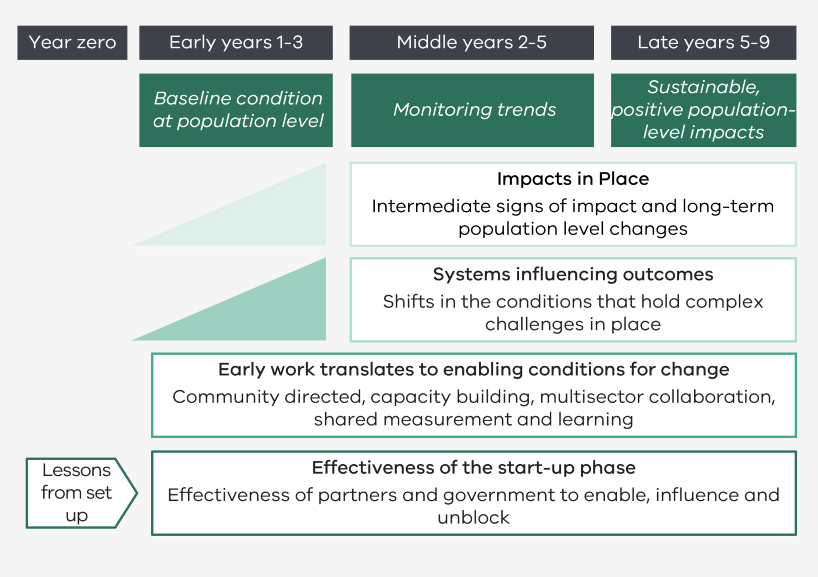In this section we have provided an example set of measurement areas, organised against levels of a generic place-based theory of change. These measurement areas can be used to inform indicator development in place-based contexts. The indicators included draw on the evidence of what works in practice, including from place-based approaches within Victoria, nationally and abroad.
While these examples provide a useful basis for developing effective indicators that demonstrate the impact of place-based approaches, the choice, adaptation and number of indicators chosen will depend on the local needs and context and the unique theories of change, as well as the sorts of data that is available for MEL. Furthermore, measurement areas suggested will need to be turned into indicators.
The timeframes ascribed to measurement areas are intended as a rough guide only and refer to the time period that you would expect change to occur in. The timing will vary depending on contextual factors, including the readiness and maturity of the place-based approach. It may also be important to begin measuring outcome areas before change is expected (e.g. by establishing a baseline).
Our example measures align with guidance on how change can occur over time.
Source: adapted from the Place based evaluation framework, national guide for evaluation of place-based approaches in Australia (PDF, 3.7 MB).
Building enablers for change (1+ years)
These measurement areas focus on the critical enablers to do place-based work well. While it is important to track the progress and health of these critical aspects throughout the initiative, these can be particularly helpful for assessing progress in the formative years, well before any longer term outcomes are expected to occur.
| Focus | Measurement areas |
|---|---|
|
Coordination governance and partnerships |
|
|
Systems understanding and innovation |
|
|
Enabling infrastructure and resourcing |
|
Systems influencing outcomes (3-5+ years)
When talking about systems change, we mean shifting the conditions that hold complex problems in place, including the explicit (policies, practices and resources), semi-explicit (relationships, connections, and power dynamics) and implicit (mindsets). These often relate to people and institutions beyond the geographically defined boundaries of the place-based initiative.
| Focus | Measurement areas |
|---|---|
|
Changes to mindsets and attitudes |
|
|
Community agency and activation |
|
|
Structural policy change (funding, service alignment and resourcing) |
|
Impacts in place
Focus on how outcomes and livelihoods for target population/groups may be changing or has already changed as a result of the place-based approach.
| Focus | Measurement areas |
|---|---|
|
Early and intermediate signs of impact |
Depending on the problem or opportunity being addressed in community, there may be scholarly frameworks and theories that can be used to support the identification of early signs of change (for example, in health, these could be pre-determinants). Additionally, while population level change may still be a while off, you may expect to see positive early impacts for target cohorts e.g. resulting from pilots or high leverage activities with a smaller section of the community. Example measurement areas include:
|
|
Long-term population level changes |
Access to meaningful population level data often requires government to support facilitated access to State and Commonwealth data which should be aligned to Departmental or Whole of Victorian Government Outcomes Frameworks where possible.
Example domains include:
|
Example indicator banks
- ARACY NEST
The Nest is Australia’s first evidence-based framework for national child and youth wellbeing, (0-24 years), focussed across six wellbeing domains: Loved and Safe, Material Basics, Healthy, Learning, Participating and Positive Sense of Identity and Culture. - Centre for Social Impact’s Indicator Engine
A platform to support users to identify outcomes and indicators relevant for their measurement needs in a way that aligns to best-practice by using published sector frameworks or internal organisational frameworks. The platform can also produce and distribute surveys, therefore supporting users from start to finish in identifying the most suitable outcomes and indicators to measure in survey format. - Victorian Population Health Survey
The Victorian Population Health Survey (VPHS) is the cornerstone of population health surveillance. The VPHS collects information at the state, regional and local government area levels about the health and wellbeing of adult Victorians aged 18 years or older. - Closing the Gap
The National Agreement on Closing the Gap has 17 targets for Aboriginal and Torres Strait Islander people, across the following outcome areas, to enable them to achieve life outcomes equal to all Australians: education, employment, health and wellbeing, justice, safety, housing, land and waters, and languages. - VicHealth partnerships analysis tool
This resource is for organisations entering into or working in a partnership to assess, monitor and maximise its ongoing effectiveness. - Evaluating Systems Change Results: An Inquiry Framework
This paper is designed to give clarity on how to approach the evaluation of systems change and provides three types of results that social innovators and evaluators should consider “mission-critical” to their work. - UK Measurement Framework for Equality and Human Rights
The Measurement Framework is used by the Equality and Human Rights Commission to monitor equality and human rights in Britain. Progress is measured across six domains: education, work, living standards, health, justice and personal security and participation. - Mayi Kuwayu: The National Study of Aboriginal and Torres Strait Islander Wellbeing
The Mayi Kuwayu Study aims to understand how Aboriginal and Torres Strait Islander health and wellbeing is linked to things like connection to country, cultural practices, spirituality and language use. Organisations can apply to use this data for Aboriginal and Torres Strait Islander health and wellbeing studies.
Updated
